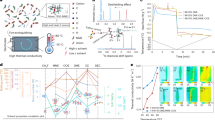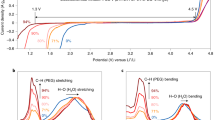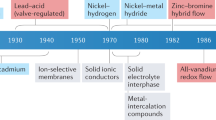Abstract
Designing anti-freezing electrolytes through choosing suitable H2O–solute systems is crucial for low-temperature aqueous batteries (LTABs). However, the lack of an effective guideline for choosing H2O–solute systems based on decisive temperature-limiting factors hinders the development of LTABs. Here we identified two decisive factors: thermodynamic eutectic temperature (Te) and kinetic glass-transition temperature (Tg), with Tg being applicable for LTABs only when H2O–solute systems have strong super-cooling ability. We proposed a general strategy wherein low-Te and strong-super-cooling ability electrolytes can be realized by creating multiple-solute systems via introducing assisted salts with high ionic-potential cations (for example, Al3+, Ca2+) or cosolvents with high donor numbers (for example, ethylene glycol). As a demonstration in Na-based systems, we designed electrolytes with ultralow Te (−53.5 to −72.6 °C) and Tg (−86.1 to −117.1 °C), showcasing battery performances including 80 Wh kg−1 and 5,000 cycles at 25 °C, and 12.5 Wh kg−1 at −85 °C. The work provides effective guidelines for the design of anti-freezing electrolytes for extremely low-temperature applications.
This is a preview of subscription content, access via your institution
Access options
Access Nature and 54 other Nature Portfolio journals
Get Nature+, our best-value online-access subscription
$29.99 / 30 days
cancel any time
Subscribe to this journal
Receive 12 digital issues and online access to articles
$119.00 per year
only $9.92 per issue
Buy this article
- Purchase on Springer Link
- Instant access to full article PDF
Prices may be subject to local taxes which are calculated during checkout





Similar content being viewed by others
Data availability
The datasets analysed and generated during the current study are included in the paper and its Supplementary Information.
References
Xu, J. et al. Electrolyte design for Li-ion batteries under extreme operating conditions. Nature 614, 694–700 (2023).
Rodrigues, M.-T. F. et al. A materials perspective on Li-ion batteries at extreme temperatures. Nat. Energy 2, 17108 (2017).
Zhu, G. et al. Rechargeable Na/Cl2 and Li/Cl2 batteries. Nature 596, 525–530 (2021).
Ai, F. et al. Heteropoly acid negolytes for high-power-density aqueous redox flow batteries at low temperatures. Nat. Energy 7, 417–426 (2022).
Jiang, L. W., Hu, Y.-C., Ai, F., Liang, Z. J. & Lu, Y.-C. Rational design of anti-freezing electrolyte concentrations via freeze concentration process. Energy Environ. Sci. 17, 2815–2824 (2024).
Jiang, L., Dong, D. & Lu, Y.-C. Design strategies for low temperature aqueous electrolytes. Nano Res. Energy 1, e9120003 (2022).
Guo, Q., Han, S., Lu, Y., Chen, L. & Hu, Y.-S. Low-temperature aqueous Na-ion batteries: strategies and challenges of electrolyte design. Chin. Phys. Lett. 40, 028801 (2023).
Yue, J. et al. Aqueous interphase formed by CO2 brings electrolytes back to salt-in-water regime. Nat. Chem. 13, 1061–1069 (2021).
Jiang, L. et al. Building aqueous K-ion batteries for energy storage. Nat. Energy 4, 495–503 (2019).
Zhang, Q. et al. Chaotropic anion and fast-kinetics cathode enabling low-temperature aqueous Zn batteries. ACS Energy Lett. 6, 2704–2712 (2021).
Tang, L. et al. Strengthening aqueous electrolytes without strengthening water. Angew. Chem. Int. Ed. 62, e202307212 (2023).
Qiu, M. et al. Tailoring water structure with high-tetrahedral-entropy for antifreezing electrolytes and energy storage at −80 °C. Nat. Commun. 14, 601 (2023).
Zhu, K. et al. Inorganic electrolyte for low‐temperature aqueous sodium ion batteries. Small 18, 2107662 (2022).
Zhu, K. et al. Tailoring pure inorganic electrolyte for aqueous sodium‐ion batteries operating at −60 °C. Batter. Supercaps. 5, e202200308 (2022).
Nian, Q. S. et al. Aqueous batteries operated at −50 °C. Angew. Chem. Int. Ed. 58, 16994–16999 (2019).
Suo, L. et al. ‘Water-in-salt’ electrolytes enable green and safe Li-ion batteries for large scale electric energy storage applications. J. Mater. Chem. A 4, 6639–6644 (2016).
Nian, Q. et al. Regulating frozen electrolyte structure with colloidal dispersion for low temperature aqueous batteries. Angew. Chem. Int. Ed. 62, e202217671 (2023).
Sun, Y. et al. Salty ice electrolyte with superior ionic conductivity towards low‐temperature aqueous zinc ion hybrid capacitors. Adv. Funct. Mater. 31, 2101277 (2021).
Guo, Z. et al. An organic/inorganic electrode-based hydronium-ion battery. Nat. Commun. 11, 959 (2020).
Sui, Y. et al. Reversible Cl2/Cl– redox for low-temperature aqueous batteries. ACS Energy Lett. 8, 988–994 (2023).
Jiang, L. & Lu, Y.-C. Building a long-lifespan aqueous K-ion battery operating at −35 °C. ACS Energy Lett. 9, 985–991 (2024).
Zhang, Q. et al. Modulating electrolyte structure for ultralow temperature aqueous zinc batteries. Nat. Commun. 11, 4463 (2020).
Monnin, C., Dubois, M., Papaiconomou, N. & Simonin, J.-P. Thermodynamics of the LiCl+ H2O system. J. Chem. Eng. Data 47, 1331–1336 (2002).
Wang, Q., Zhao, L., Li, C. & Cao, Z. The decisive role of free water in determining homogenous ice nucleation behavior of aqueous solutions. Sci. Rep. 6, 26831 (2016).
Corti, H. R., Nores-Pondal, F. J. & Angell, C. A. Heat capacity and glass transition in P2O5-H2O solutions: support for Mishima’s conjecture on solvent water at low temperature. Phys. Chem. Chem. Phys. 13, 19741–19748 (2011).
Pillai, S. B., Wilcox, R. J., Hillis, B. G., Losey, B. P. & Martin, J. D. Understanding the water-in-salt to salt-in-water characteristics across the zinc chloride: water phase diagram. J. Phys. Chem. B 126, 2265–2278 (2022).
Jiang, H. et al. A high‐rate aqueous proton battery delivering power below −78 °C via an unfrozen phosphoric acid. Adv. Energy Mater. 10, 2000968 (2020).
Gibout, S., Franquet, E., Haillot, D., Bédécarrats, J.-P. & Dumas, J.-P. Challenges of the usual graphical methods used to characterize phase change materials by differential scanning calorimetry. Appl. Sci. 8, 66 (2018).
Ding, M., Xu, K. & Jow, T. Phase diagram of EC–DMC binary system and enthalpic determination of its eutectic composition. J. Therm. Anal. Calorim. 62, 177–186 (2000).
Franquet, E., Gibout, S., Bédécarrats, J. P., Haillot, D. & Dumas, J. P. Inverse method for the identification of the enthalpy of phase change materials from calorimetry experiments. Thermochim. Acta 546, 61–80 (2012).
Zhao, L., Pan, L., Cao, Z. & Wang, Q. Confinement-induced vitrification of aqueous sodium chloride solutions. Chem. Phys. Lett. 647, 170–174 (2016).
Zhao, L. S., Cao, Z. X. & Wang, Q. Glass transition of aqueous solutions involving annealing-induced ice recrystallization resolves liquid-liquid transition puzzle of water. Sci. Rep. 5, 15714 (2015).
Wang, X., Huang, W., Liu, F., Liu, N. & Huang, X. Determination and graphics expression of ice-salt eutectic points of the multicomponent electrolyte solutions. Fluid Phase Equilib. 458, 115–122 (2018).
Yu, D., Xue, Z. & Mu, T. Eutectics: formation, properties, and applications. Chem. Soc. Rev. 50, 8596–8638 (2021).
Walrafen, G. E. Raman spectral studies of the effects of temperature on water structure. J. Chem. Phys. 47, 114–126 (1967).
Hare, D. E. & Sorensen, C. M. Raman spectroscopic study of bulk water supercooled to −33 °C. J. Chem. Phys. 93, 25–33 (1990).
Wang, Y. H. et al. In situ Raman spectroscopy reveals the structure and dissociation of interfacial water. Nature 600, 81–85 (2021).
Yang, B., Cao, X., Wang, C., Wang, S. & Sun, C. Investigation of hydrogen bonding in water/DMSO binary mixtures by Raman spectroscopy. Spectrochim. Acta A Mol. Biomol. Spectrosc. 228, 117704 (2020).
Hu, Y.-C. & Tanaka, H. Physical origin of glass formation from multicomponent systems. Sci. Adv. 6, eabd2928 (2020).
Tanaka, H. Bond orientational order in liquids: towards a unified description of water-like anomalies, liquid–liquid transition, glass transition, and crystallization. Eur. Phys. J. E 35, 113 (2012).
Hu, Y.-C. & Tanaka, H. Revealing the role of liquid preordering in crystallisation of supercooled liquids. Nat. Commun. 13, 4519 (2022).
Jiang, L. et al. High-voltage aqueous Na-ion battery enabled by inert-cation-assisted water-in-salt electrolyte. Adv. Mater. 32, 1904427 (2020).
Reber, D., Kühnel, R.-S. & Battaglia, C. Suppressing crystallization of water-in-salt electrolytes by asymmetric anions enables low-temperature operation of high-voltage aqueous batteries. ACS Mater. Lett. 1, 44–51 (2019).
Wu, X. Y. et al. Energetic aqueous rechargeable sodium‐ion battery based on Na2CuFe(CN)6–NaTi2(PO4)3 intercalation chemistry. Chem. Sus. Chem. 7, 407–411 (2014).
Fernández-Ropero, A. J., Saurel, D., Acebedo, B., Rojo, T. & Casas-Cabanas, M. Electrochemical characterization of NaFePO4 as positive electrode in aqueous sodium-ion batteries. J. Power Sources 291, 40–45 (2015).
Zhang, Y. et al. All-climate aqueous Na-ion batteries using ‘water-in-salt’ electrolyte. Sci. Bull. 67, 161–170 (2022).
Yue, J. et al. Interface concentrated‐confinement suppressing cathode dissolution in water‐in‐salt electrolyte. Adv. Energy Mater. 10, 2000665 (2020).
Ding, M. S. & Xu, K. Phase diagram, conductivity, and glass transition of LITFSI–H2O binary electrolytes. J. Phys. Chem. C. 122, 16624–16629 (2018).
Kresse, G. & Furthmüller, J. Efficient iterative schemes for ab initio total-energy calculations using a plane-wave basis set. Phys. Rev. B 54, 11169 (1996).
Kresse, G. & Furthmüller, J. Efficiency of ab-initio total energy calculations for metals and semiconductors using a plane-wave basis set. Comput. Mater. Sci. 6, 15–50 (1996).
Perdew, J. P., Burke, K. & Ernzerhof, M. Generalized gradient approximation made simple. Phys. Rev. Lett. 77, 3865 (1996).
Dion, M., Rydberg, H., Schroder, E., Langreth, D. C. & Lundqvist, B. I. Van der Waals density functional for general geometries. Phys. Rev. Lett. 92, 246401 (2004).
Nosé, S. A unified formulation of the constant temperature molecular dynamics methods. J. Chem. Phys. 81, 511–519 (1984).
Hoover, W. G. Canonical dynamics: equilibrium phase-space distributions. Phys. Rev. A 31, 1695 (1985).
Martínez, L., Andrade, R., Birgin, E. G. & Martínez, J. M. PACKMOL: a package for building initial configurations for molecular dynamics simulations. J. Comput. Chem. 30, 2157–2164 (2009).
Acknowledgements
This work was supported by the National Natural Science Foundation of China (grant nos. 52122214 received by Y.L. and 52072370 received by J.Z.), Youth Innovation Promotion Association of the Chinese Academy of Sciences (grant no. 2020006 received by Y.L.), Jiangsu Province Carbon Peak and Neutrality Innovation Program (Industry tackling on prospect and key technology grant no. BE2022002-5 received by Y.-S.H.), Beijing Natural Science Foundation (grant no. 2222078 received by J.Z.), Guangxi Power Grid Project (grant no. GXKJXM20210260 received by Y.-S.H.) and the Research Grant Council of the Hong Kong Special Administrative Region, China (grant nos. CUHK 14308622 and C1002-21G received by Y.-C.L.). We are grateful to B. Dunn for his suggestions on understanding electrolyte performance and mechanisms.
Author information
Authors and Affiliations
Contributions
L.J., Y.-S.H., J.Z., Y.-C.L. and Y.L. conceived the project. L.J. synthesized the NaFeMnHCF cathode and carried out electrochemical tests, DSC tests, AIMD simulations and DFT calculations. S.H. synthesized the NaTi2(PO4)3 anode and carried out NMR and DSC tests. Y.-C.H. contributed to the electrolyte strong-SCA mechanisms. L.J., S.H., Y.-C.H., Y.L, Y.-C.L., J.Z. and Y.-S.H. wrote the paper. All the authors participated in the preparation of paper.
Corresponding authors
Ethics declarations
Competing interests
Y.-S.H. is employed by HiNa Battery Technology Co., Ltd. The other authors declare no competing interests.
Peer review
Peer review information
Nature Energy thanks Xiulei Ji and the other, anonymous, reviewer(s) for their contribution to the peer review of this work.
Additional information
Publisher’s note Springer Nature remains neutral with regard to jurisdictional claims in published maps and institutional affiliations.
Supplementary information
Supplementary Information
Supplementary Notes 1–4, Figs. 1–24 and Tables 1–7.
Rights and permissions
Springer Nature or its licensor (e.g. a society or other partner) holds exclusive rights to this article under a publishing agreement with the author(s) or other rightsholder(s); author self-archiving of the accepted manuscript version of this article is solely governed by the terms of such publishing agreement and applicable law.
About this article
Cite this article
Jiang, L., Han, S., Hu, YC. et al. Rational design of anti-freezing electrolytes for extremely low-temperature aqueous batteries. Nat Energy (2024). https://doi.org/10.1038/s41560-024-01527-5
Received:
Accepted:
Published:
DOI: https://doi.org/10.1038/s41560-024-01527-5



